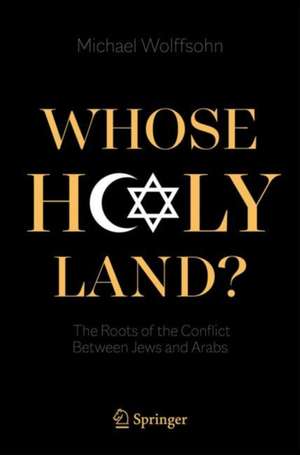Whose Holy Land?: The Roots of the Conflict Between Jews and Arabs
Autor Michael Wolffsohnen Limba Engleză Paperback – 16 oct 2021
This book explains the historical roots of the conflict between Jews and Arabs, which has lost none of its explosiveness to the present day, in a comprehensive and easy-to-understand manner.
The question of who owns the Holy Land is more relevant today than ever. The debates on this topic are often characterized by ignorance and strong emotions, while partiality and power interests still obscure the view on the political situation in the Middle East.
Shaking up old myths and prejudices, this book presents an overall historical as well as political analysis of the Jewish, Christian, and Muslim structures, actors, and actions from the very beginning to this very day, as well as a topical analysis. It combines history with theology and political science.
Thus, the book is a must-read for scholars and students of political science, history, and international relations, as well as policy-makers, interested in a better understanding of the historical background and current political situation in the Middle East.
Preț: 181.87 lei
Nou
Puncte Express: 273
Preț estimativ în valută:
34.82€ • 36.26$ • 28.89£
34.82€ • 36.26$ • 28.89£
Carte disponibilă
Livrare economică 24 ianuarie-07 februarie
Livrare express 09-15 ianuarie pentru 42.73 lei
Preluare comenzi: 021 569.72.76
Specificații
ISBN-13: 9783030742850
ISBN-10: 3030742857
Pagini: 205
Ilustrații: XVII, 222 p. 15 illus.
Dimensiuni: 155 x 235 x 13 mm
Greutate: 0.37 kg
Ediția:1st ed. 2021
Editura: Springer International Publishing
Colecția Springer
Locul publicării:Cham, Switzerland
ISBN-10: 3030742857
Pagini: 205
Ilustrații: XVII, 222 p. 15 illus.
Dimensiuni: 155 x 235 x 13 mm
Greutate: 0.37 kg
Ediția:1st ed. 2021
Editura: Springer International Publishing
Colecția Springer
Locul publicării:Cham, Switzerland
Cuprins
Holy Land? Israel? Palestine?.- RELIGIOSITY AND POLITICS.- The Pious, the Zealous and a "Dead" God.- Fundamentalism - A Shield for the Culture?.- Is Zionism Blasphemy?.- Zionism in the Quran?.- THE HOLY LAND, RELIGIONS AND POLITICS.- What Is the Holy Land? - Biblical Borders?.- Why Is the Land Holy?.- To Whom Is the Land Holy?.- Where Is the Land Holy? Or: To Whom Does Jerusalem Belong?.- How Is the Land Holy? Or: Holiness and Statehood.- By What Means Is the Land Acquired?.- THE HISTORY OF CHANGING OWNERSHIP.-Whose Possession? Whose Property?.-Names and Power.- The Patriarch Fathers.- Jewish Settlement as “Conquest”.- Kingdom and Kingdoms Come and Go.- Exile, Return and Autonomy.- The Europeanization of the Holy Land.- Christians as Heirs and Owners.- Re-Orientalisation - Arabisation, Turkification.- Re-Europeanization.- The Return of Islam.- The Return to Zion.- The British in the Holy Land.- The Founding of Israel -- Palestine Becomes Jordan.- “Greater Israel” -- Jewish or Democratic? Of Federations and Confederation.- Injustice for Injustice – Conclusion – Solution?.
Notă biografică
Michael Wolffsohn was born in 1947 in Tel Aviv, Israel. He is a Professor Emeritus for Modern History at the University of the German Armed Forces in Munich, Germany. In 2017 he was awarded the title of Germany´s “Professor of the Year”. Wolffsohn is the author of numerous books on the Middle East, International Relations, Global Jewish History, and Historical Demoscopy.
Textul de pe ultima copertă
This book explains the historical roots of the conflict between Jews and Arabs, which has lost none of its explosiveness to the present day, in a comprehensive and easy-to-understand manner.
The question of who owns the Holy Land is more relevant today than ever. The debates on this topic are often characterized by ignorance and strong emotions, while partiality and power interests still obscure the view on the political situation in the Middle East.
Shaking up old myths and prejudices, this book presents an overall historical as well as political analysis of the Jewish, Christian, and Muslim structures, actors, and actions from the very beginning to this very day, as well as a topical analysis. It combines history with theology and political science.
Thus, the book is a must-read for scholars and students of political science, history, and international relations, as well as policy-makers, interested in a better understanding of the historical background and current political situation in the Middle East.
Caracteristici
Explains the various issues from all possible angles Offers historical and religious information rather than indoctrination Presents a completely new approach to conflict resolution: A synthesis of federations and confederations
